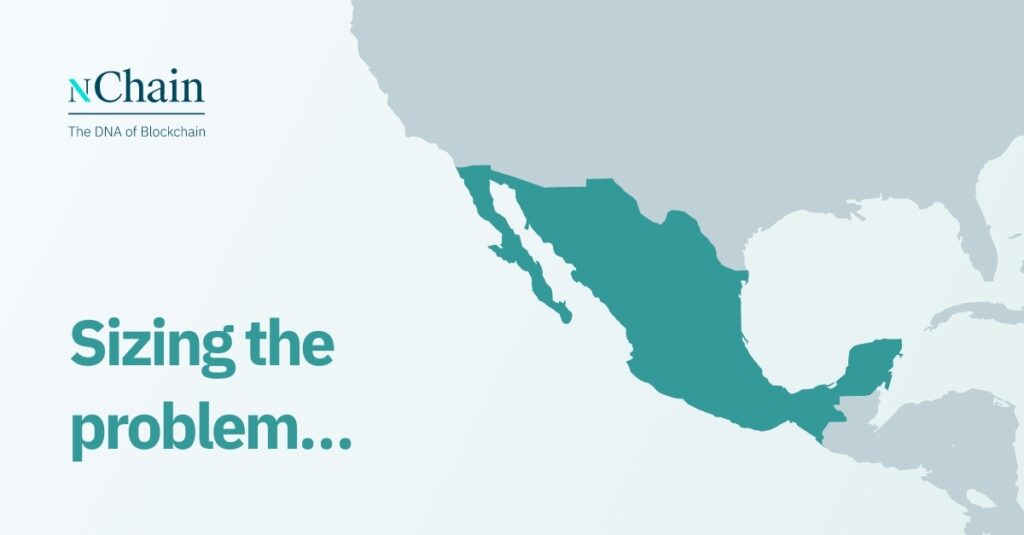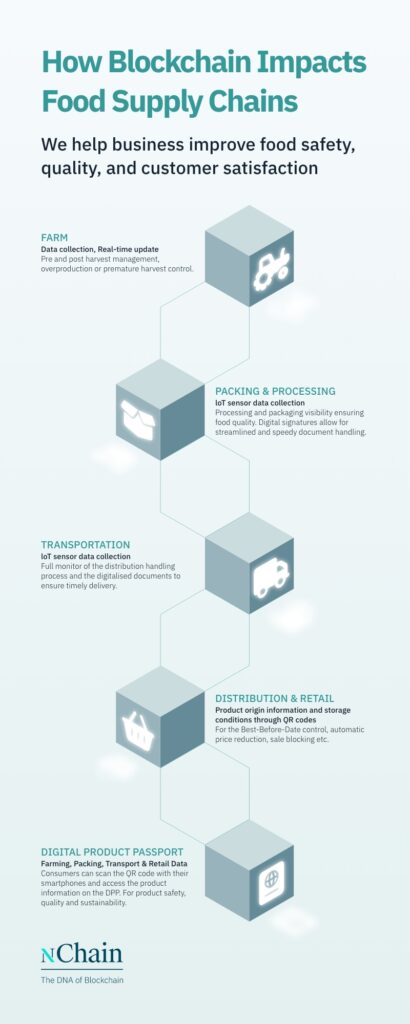Global food waste affects 870 million undernourished people, not to mention the damage to our environment and climate change. Blockchain technology can bring about increases in transparency, automation, and efficiency of processes across the whole perishable foods supply chain that will facilitate the elimination of these problems.
Blockchain can bring full traceability to even the most complex of supply chains in the perishable food market. While the global perishable food market is once again growing more profitable after the Covid-19 era – it grew up to $152.24 billion by the end of 2022 and continues to grow at a compound annual growth rate of 9.5% per year – it still faces other pressures. Factors such as regulatory compliance, the fragmented nature of the supply chain in this space, and the high levels of food waste and loss are challenging the industry’s expedience.
The problem with food waste in global supply chains
Each year, 1.6 billion tons of food worth about $1.2 trillion are lost or go to waste—one-third of the total amount of food produced globally[1]. To put these figures in perspective, the weight of the food lost or wasted each year is equivalent to the value of over 320 million elephants[2] and its monetary value could be roughly equivalent to the GDP of Mexico or Indonesia[3].

The impact
The phenomenon of food loss and waste affects the society, the environment, and the global economy.
- Social Impact: Food waste has significant social implications, as it affects food security and access to nutritious food. According to the Food and Agriculture Organisation of the United Nations (FAO), “if we save one fourth of the food currently lost or wasted, we can feed 870 million hungry people”. And this should not be considered a problem of the weakest economies only. In the UK specifically, food poverty and insecurity are rising at an alarming rate: 7 million people currently struggle to get enough to eat, 2 million of whom are children[4].
- Environmental: The scale of the environmental impact of food waste affects the delicate balance of our environmental ecosystem as it contributes to climate change and the reduction of valuable natural resources such as water, energy, and land. The 1.6 billion tons of food that are lost and wasted annually are estimated to account for 8% of global greenhouse gas emissions[5].
- Economic: Food waste threatens the profitability and viability of businesses related to the food industry – from the smallest farmers to the biggest retailers. The Boston Consulting Group (BCG) estimates that by 2030 annual food loss and waste will hit 2.1 billion tons, equivalent to $1.5 trillion globally[6]. Much of this waste is not waste at all. The Waste and Resources Action Programme (WRAP) estimates that in the UK 56% of all waste was avoidable and had a potential sales value of £1.9 billion[7].
The roots of the problem
The main reasons the problem of food waste and loss has not been addressed effectively yet could be summarised in the following factors:
- Lack of awareness: The limited visibility of the extent of food loss and waste and the lack of awareness of their roots across the supply chain result in insufficient response against the problem.
- Incomplete supply chain infrastructure: A significant amount of food is lost due to spoilage or damage before even it can get to markets and consumers[8].
- Lack of supply chain efficiency: According to BCG, companies have been slow to adopt digital supply chain management tools that make transactions in the supply chain more efficient and seamless and enable the tracking of loss and waste.
- Insufficient collaboration tools: Similarly, the lack of tools for traceability and coordination among different stakeholders across the value chain, contributes significantly to overproduction, inefficiencies, loss, and waste.
- Inadequate policy: Food disposal is still an easy option for companies because of insufficient regulatory provisions. A stricter legal framework could prompt both businesses and consumers to be more considerate and responsible of the waste they create.
The solution
BCG have identified key initiatives to address these problems; the widespread adoption of digital supply chain solutions and tools could generate efficiencies to save $120 billion annually[9]; and implementing cutting-edge technologies to improve supply chain infrastructure and promote better collaboration could save $150 and $60 billion respectively[10].
Blockchain is a central technology in enabling these initiatives and is becoming widely adopted by the supply chain industry. The current market size of blockchain in the supply chain industry is $17.15 billion and is anticipated to grow at a CAGR of 45.55% from 2022 to 2030[11].

The role of blockchain in supply chain
The tamper-proof, decentralized nature of public blockchain technology ensures data integrity and builds confidence among producers, importers, retailers, and consumers. It also enables supply chain actors to share data and information securely and transparently in real-time. Key innovations blockchain can bring to the perishable food supply chain that will help solve the food waste phenomenon:
- Identify the source of the problem the moment it happens: Full transparency and traceability across the supply chain can help identify inefficiencies such as inadequate storage and transport conditions that can cause spoilage or contamination of perishable goods.
- Cost efficiency and enhanced trust: Blockchain technology can be used to automate and improve the efficiency of administrative functions across the supply chain resulting in faster and more cost-effective operations. In addition, the tamper-proof, decentralized nature of public blockchain technology ensures data integrity.
- Full control and better management: Broaden visibility at each stage of production and the automation of manual data entry allow businesses to implement targeted measures to reduce spoilage and optimize resource utilization. Furthermore, traceability enables producers to monitor their products throughout distribution handling, ensuring quality delivery times are maintained and improved.
At nChain we have been pioneering in the blockchain space for the past 8 years to build a broad IP portfolio that can empower the most scalable infrastructure which can seamlessly support the density and complexity of demanding networks such as that of the food supply chain market. We also partner with leading-edge companies from within the supply chain space, such as Unisot, to combine long industry experience, unmatched expertise, and exceptional delivery capabilities.
To find out more about our supply chain services as well as nChain’s vast solutions portfolio reach out to one of our experts today.
References
[1] BCG estimates that by 2030 annual food loss and waste will hit 2.1 billion tons worth $1.5 trillion. https://www.bcg.com/publications/2018/tackling-1.6-billion-ton-food-loss-and-waste-crisis
[2] https://www.fao.org/3/i2697e/i2697e.pdf
[3] https://data.worldbank.org/indicator/NY.GDP.MKTP.cd
[4] https://www.wwf.org.uk/press-release/hidden-waste-report-shines-light-uk-food-waste
[5] https://www.bcg.com/publications/2020/recipe-to-reduce-food-loss-and-waste
[6] https://www.bcg.com/publications/2018/tackling-1.6-billion-ton-food-loss-and-waste-crisis
[7] https://wrap.org.uk/resources/report/quantification-food-surplus-waste-and-related-materials-supply-chain
[8] https://www.bcg.com/featured-insights/closing-the-gap/food-waste
[9] https://www.bcg.com/publications/2018/tackling-1.6-billion-ton-food-loss-and-waste-crisis
[10] https://www.bcg.com/publications/2018/tackling-1.6-billion-ton-food-loss-and-waste-crisis
[11] https://www.globenewswire.com/news-release/2023/4/5/2641830/0/en/Blockchain-in-Supply-Chain-Market-Anticipated-to-Grow-at-a-CAGR-of-45-55-During-2022-To-2030-Report-by-Market-Research-Future-MRFR.html